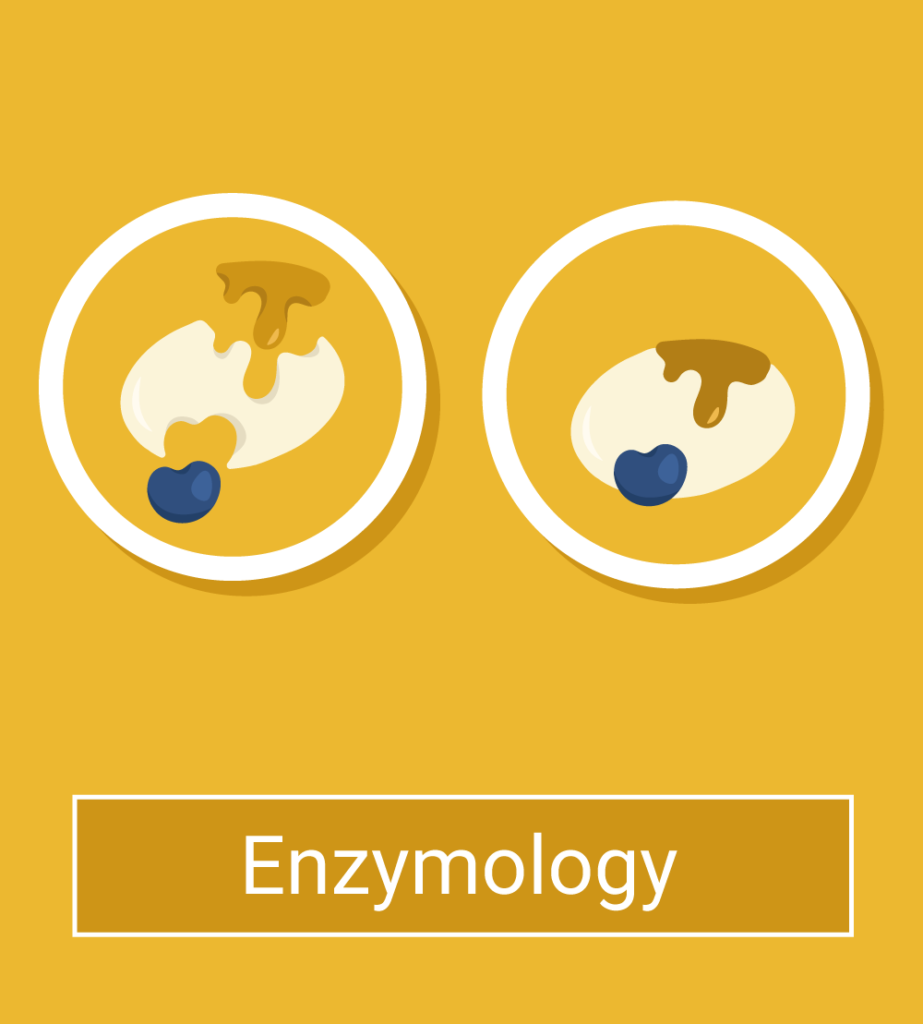

Enzymes are regarded as the keys that control cellular activities. A single cellular task is accomplished through a series of interconnected biochemical reactions in the metabolic pathway. Each reaction must take place in sequence and be catalyzed by a specific enzyme that only acts upon its substrate.
The resulting product from the catalyzed reaction typically acts as the substrate of the next reaction. Thus, the abundance and the activity of the enzymes in the corresponding pathway influence the metabolic flux, or the turnover rate of the metabolites, which, in turn, affect the overall cellular activities.[1]
The overall rate of the entire metabolic pathway is governed by one chemical reaction of the pathway called the rate-limiting reaction. Also known as the rate-determining step, this metabolic reaction proceeds at the slowest rate and is regulated through the activity of a regulatory enzyme, whose catalytic activity relies on its interaction with a smaller signal molecule. The interaction can occur in the form of covalent modification or in non-covalent interaction.[1, 2, 3]
Allosteric enzymes are a group of regulatory enzymes whose catalytic activities are controlled by noncovalent binding to other molecules called effectors or modulators.[3]
They possess the following characteristics:
The word allosteric stems from two words in Greek: allos which means other, and stereos which means space. Together, it reflects the type of regulation in which the binding of a molecule on one site directly impacts the binding of another molecule on another spatially distinct site.[1]
Thus, allosteric enzymes are generally multi-subunit proteins, consisting of one subunit that performs a catalytic function and at least, another subunit that performs a regulatory function.[4]
The catalytic subunit of an allosteric enzyme is similar to other typical enzymes: it contains an active site that binds to the complementary substrate to initiate the enzyme’s catalytic activity.[1,4] The regulatory subunit comprises a regulatory site, also referred to as an allosteric site, which binds to an effector molecule to influence the activity of the catalytic subunit.
The binding of the effector to the regulatory site transmits messages to the catalytic subunit in the form of conformational changes, to modify conformational changes of the active site, thereby influencing the catalytic activity of the enzyme.[2, 3]
The binding of effectors to the regulatory site to the catalytic activity can be heterotrophic or homotropic. If the effector is a small ligand molecule, and its binding to the regulatory site on an allosteric enzyme affects the binding on the catalytic subunit of the substrate or another ligand, the enzyme is said to exhibit a heterotropic interaction.
Conversely, homotropic interaction refers to when the binding of its substrate or ligand on one subunit of an allosteric enzyme affects the binding affinity of the same substrate on another subunit of the enzyme.[2,4]
The binding of the effector to the allosteric site can trigger positive cooperativity when the binding increases the affinity between the successive binding of the substrate and the active site. Effector-regulatory site binding can also invoke negative cooperativity if the binding activity of the enzyme that follows is impeded.[1-3]
The kinetics of most enzymes follow the hyperbolic curve of the Michaelis-Menten Equation. At the initial stage of an enzymatic reaction, the relationship between the reaction turnover rate and the substrate concentration is linear, given a constant enzyme concentration — the rate of the reaction increases as the substrate concentration increases.
However, as the reaction proceeds, more and more substrates occupy the enzyme’s active sites, and the increase in the substrate concentration at a certain point has little effect on the reaction rate. At this stage, the relationship between the reaction rate and concentration of the substrate is no longer linear and plateaus when the active site of the enzyme molecules are fully occupied, becoming saturated.[1,3]
In a reaction catalyzed by an allosteric enzyme, the reaction turnover rate is also dependent on the substrate concentration, but the relationship between the two follows a sigmoid growth curve. The curve is typically seen in a pattern of population growth, which can be divided into three distinct phases: exponential, linear, and plateau.[1 – 4]
At the initial stage of an allosteric enzyme-catalyzed reaction, the reaction rate increases exponentially as the substrate increases. As the reaction progresses, the concentration of the substrate still influences the reaction rate, and their relationship is switched to the linear phase as more ligand or substrate molecules bind to the respective sites and successive enzyme-substrate binding activities are rapidly amplified or suppressed.
Eventually, the influence of the substrate concentration on the reaction rate ceases when the enzyme molecules become saturated, and the reaction rate reaches a flat plateau.[3-4]
The regulation of allosteric enzymes is based on the idea that their subunits exist in two interchangeable conformational states: relaxed (R) or tense (T).
In the R state, the subunit is active and has a higher ligand-binding affinity than in the T state. To date, two models can be used to explain the molecular and kinetics of allosteric enzymes:[3, 4]
Also known as the Manod-Wyman-Changeux Concerted Model, the symmetry model is applied to allosteric enzymes comprising dimers, each with catalytic sites.[1,3]
This model assumes that the two subunits exist in the same state, and the enzyme is present in the equilibrium of R and T. Since the ligand or substrate of an allosteric enzyme binds preferentially to the R state, the equilibrium shifts towards the R state as the substrate concentration increases.
The conformational change in one subunit is in concert with the other, maintaining the symmetry of the enzyme. In other words, the enzyme in the symmetry model exists in either RR or TT and not in the RT state.[3, 4]
Unlike the other model, the sequential model does not assume that the enzyme exists in R and T equilibrium, nor does it dictate that subunits of an allosteric enzyme must always exist in the same conformational state.
In this model, the ligand-binding or substrate-binding induces a conformational change of the subunit from T to R state to accommodate the binding. The conformational change of one subunit reshapes its interface to the neighboring subunit, which consequently, alters the binding affinity of the neighboring subunit.
As the concentration of the ligand or substrate increases, more subunits undergo a conformational change to ‘fit’ with the ligand or substrate, which subsequently modifies the affinity of the other subunits in the process.[1,3, 4]
The activity of an allosteric enzyme is subjected to the presence of its effector and the kinetics to the concentration of the effector.
This effector-dependency affords allosteric enzymes with not only a means to switch their activity on or off but also a checkpoint for feedback inhibition that adjusts the metabolic activity in response to the cellular signals.
Examples of allosteric enzymes that regulate notable metabolic pathways are:
Allosteric enzymes are a group of enzymes whose catalytic activities are dependent on the effector’s presence and abundance, and the reactions they catalyze do not follow the typical Michaelis-Menten kinetics.
The switch-like nature of the enzymes supplies them with a way to fine-tune and amplify their catalytic activities. These characteristics are essential to their roles as regulatory enzymes that govern the overall rate of the metabolic pathways to ensure promptness in the response to the cells’ needs.

Monday – Friday
9 AM – 5 PM EST
DISCLAIMER: ConductScience and affiliate products are NOT designed for human consumption, testing, or clinical utilization. They are designed for pre-clinical utilization only. Customers purchasing apparatus for the purposes of scientific research or veterinary care affirm adherence to applicable regulatory bodies for the country in which their research or care is conducted.